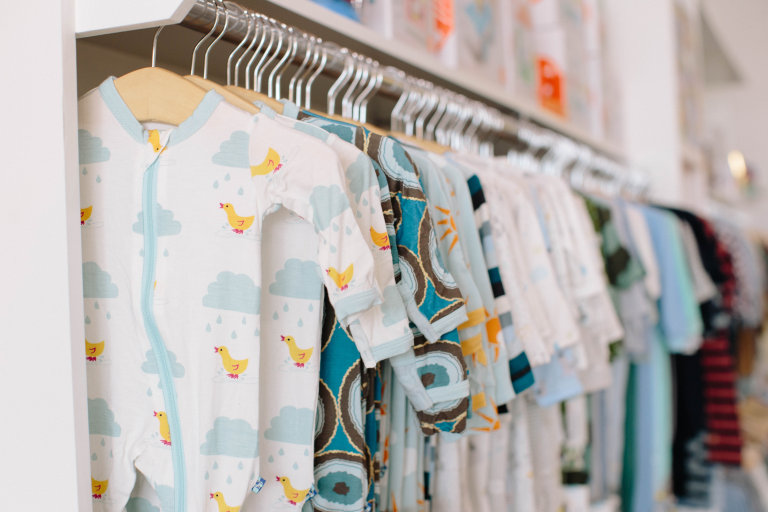
How to Register for Baby Clothes
Here's how to get the clothing you need, so you don't get 50 bodysuits, all in newborn size.

By Amylia Ryan
In This Article
You might be tempted to register for every single tiny outfit, but to make the most of the clothes on your registry, there are a few things you might want to consider: How many pieces in each size do you actually need? What if something you want is out of stock by the time your guests are shopping from your registry? And what are the very best baby clothes out there?
Here’s everything you need to know about registering for baby clothes.
Registering for sizes
Sure, it would make sense to load your registry up with newborn sizes—your baby will be a newborn, after all. But newborns don’t come in a one-size-fits-all package. A lot of babies can fit into newborn-size clothes, but some are born already fitting into three-month sizes! And premature babies are going to need smaller, preemie-size outfits. You really won’t know what size your baby will fit into until they arrive, and not all baby clothing brand sizes are exactly the same, so it’s a good idea to have a variety of the smaller sizes (preemie through three months) ready for when baby arrives.
Our best advice when registering for baby clothing is to either add the same piece of clothing in multiple sizes or add a note to each item asking gift-givers to buy other sizes as well. This will help ensure you don’t end up with 50 adorable newborn bodysuits.
The other issues with sizing? Babies outgrow clothes in the blink of an eye, so don’t choose all their clothes in just the smaller sizes. You’ll end up with more clothes in the early weeks than your baby has time to wear before they’ve outgrown them. No matter what styles you pick, make sure your registry has a variety of sizes covered for bodysuits, pants, pajamas, socks, etc.
When you’re preparing for a newborn, you probably won’t be actively thinking about a six-month-old or a nine-month-old baby. But your little one will reach those bigger sizes before you know it, and you’ll be glad to have at least a few outfits on hand that fit.
Focus on style, not specifics
We’d hate to break it to you, but baby clothes that aren’t the basics tend to have high turnover rates in stores. If you register for a particular outfit in May but your baby isn’t due until October, by the time someone tries to buy that outfit for your baby shower, it may not be in stock anymore. A lot of clothing is seasonal, so you might get lucky, and it’ll be on clearance as it’s on its way out, but it might not be in the size you were hoping for.
That’s not to say we don’t think you should register for the cutesy, fashionable baby clothes. Far from it! But to combat potential stock issues down the road, you can use your registry as more of a baby clothing mood board. Register for the clothes you want, and let your friends and family know that you’d like clothes that are similar to what you picked out since those exact items might not be available come shower time.
Don’t forget the baby clothes basics
While all the adorable patterned, styled clothes may go out of season faster than you hope, there are certain baby clothing basics that will always be available, no matter the season and no matter the trends. Items like white or neutral-colored bodysuits (both short-sleeved and long-sleeved), solid joggers or footie pants, white or grey socks—anything that’s neutral, unpatterned and more plain than fashionable is a clothing basic. And you’ll want them on your registry.
Brands like Carter’s, Burt’s Bees Baby, H&M, Tiny Kind and Old Navy have great options for covering all the basics of baby clothes, and the patterns and solid colors will never go out of style.
Used baby clothes
Looking to save a little money? We love used baby clothes as a great budget-friendly option. Whether you use your registry to ask your friends and family for their kids’ gently pre-loved clothes or you visit a secondhand store on your own, used baby clothes always cost less (sometimes a lot less) than brand-new ones. And since babies outgrow everything so quickly, pre-loved clothes tend to last through several kiddos, which is good news if you plan on having more little ones down the road.
It can often seem like there’s an endless amount of baby clothes out there, but once you’ve figured out the general style(s) you like and the different sizes you’ll likely need, it’s smooth sailing. The final piece of the baby clothing registry puzzle—determining how many of each type of clothing you need. Curious exactly how many bodysuits, pants, booties and jackets to register for? Check out our guide on how many baby clothes you need?.